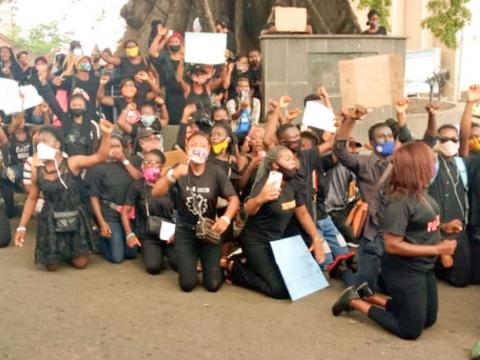By Bartholomew Bockarie Kamara
Women of all ages continue to be subjected to many different forms of violence at the hands of men. In all of Sierra Leone – from family members to colleagues and complete strangers – violence is employed to maintain male dominance over women. Despite growing public attention and government pledges to eradicate this century-old scourge, violence against women remains widespread in Sierra Leone.
One of the reasons for violence against women is the result of an imbalance of power between women and men. It is not individually experienced abuse: it needs to be understood as a means of enforcing the subordination of women. Throughout history, power relations between women and men have been unequal, resulting in male dominance over, and widespread structural discrimination against, women.
To varying degrees, patriarchal cultural and sexual norms, discriminatory divisions of power and labour, and the financial dependence of women persist in society – in our country and beyond. Violence against women is not only a result of these factors: it also reinforces them.
Women in Sierra Leone are slapped, kicked, beaten, locked up, sexually and psychologically harassed, genitally mutilated, raped, forced to prostitute themselves and killed by men in their immediate social environment, but also neglected by government officials who give deaf ears to their cry. As girls they are sexually abused in the family or at school, discriminated against in their choices of schooling or vocational training, genitally mutilated or married off against their will. As women, they are financially, psychologically and sexually abused by their partners and stalked or raped by former partners or strangers.
The different manifestations of violence against women exist across all strata of society in all of Sierra Leone to some extent. While certain factors such as ethnicity, religion, economic status, class, sexual orientation and disability shape the various forms of violence suffered, violence against women is not confined to any particular culture or region. It is its universal character that makes it an endemic form of discrimination against women.
An overview of prevalence studies in the country suggests that across the various districts, one-fifth to a quarter of all women have experienced physical violence at least once during their adult lives, while more than one-tenth have suffered sexual violence involving the use of force. This is according to the Final Activity Report on Gender Equality and Anti-Trafficking Division – Directorate General of Human Rights and Legal Affairs of the Council of Europe. It says the figures for all forms of violence, including stalking, are as high as 45%. Adding that about 12%-15% of all women have been in a relationship of domestic abuse after the age of 16, and many more continue to suffer physical and sexual violence once they are separated from the perpetrator.
According to The Executive Director of Rainbo Initiative, Daniel Kettor, "Sierra Leone recorded 1,272 cases of rape and Sexual and Gender-Based Violence (SGBV) in the last six months from its five centres across the country”. Some of the survivors are as young as two months old and some as old as 70 years old.
In addition to the traumatising physical and psychological consequences for victims, violence against women impacts directly on society – economically and socially. Analyses of the costs of violence against women reveal that it reduces the capacity of victims to contribute productively to the family, the economy and public life, and drains the resources of the social services, the justice system, health care agencies and employers. To take a broader view, it lowers the overall educational attainment, mobility and potential of a significant proportion of the population, affecting all those involved (women victims, children who witness violence and perpetrators). The costs of violence are felt in a very broad range of areas and sectors and may be direct or indirect. While they are, at times, difficult to assess, the first studies by civil society and women activists show they are extremely high.
Violence against women includes all forms of gender-based violence, whether perpetrated by family members, strangers within the community, state officials or in armed conflict. These extend, inter alia, to violence in the family or domestic unit, rape between spouses or other partners, female genital mutilation, forced marriages and other traditional practices harmful to women. But it also includes trafficking in women for the purpose of sexual exploitation and violations of the human rights of women in situations of armed conflict.
In line with this definition, violence against women is to be understood as “any act of gender-based violence, which results in, or is likely to result in, physical, sexual or psychological harm or suffering to women, including threats of such acts, coercion, or arbitrary deprivation of liberty, whether occurring in public or private life.” That, also according to the Council of Europe in an article that focuses on violence against women occurring in the family or domestic unit and certain forms of violence against women in the community. Four issues covered include domestic violence, sexual violence and rape, crimes committed in the name of honour, forced marriage and female genital mutilation, which come under the definition of violence against women.
Action to combat violence against women in our country and trafficking in women and girls should be part of society's demand and the government's agenda.
Copyright © 2020 Politico Online








